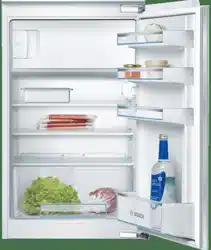Loading ...
Loading ...
Loading ...

Cleaning and servicing en
47
Cleaning the appliance
Clean the appliance as specified to
ensure that it is not damaged by in-
correct cleaning or unsuitable clean-
ing products.
WARNING
Risk of electric shock!
¡ An ingress of moisture can cause
an electric shock.
▶
Do not use steam- or high-pres-
sure cleaners to clean the appli-
ance.
¡ Liquid in the lighting can be dan-
gerous.
▶
The rinsing water must not run
into the light.
ATTENTION!
¡ Unsuitable cleaning products may
damage the surfaces of the appli-
ance.
▶
Do not use hard scouring pads
or cleaning sponges.
▶
Do not use harsh or abrasive
detergents.
▶
Do not use cleaning products
with a high alcohol content.
¡ If you clean fittings and accessor-
ies in the dishwasher, this may
cause them to become deformed
or discolour.
▶
Never clean shelves or contain-
ers in the dishwasher.
1. Prepare the appliance for cleaning.
→Page46
2. Clean the appliance, the fittings
and the door seals clean with a
dish cloth, lukewarm water and a
little pH-neutral washing-up liquid.
3. Dry thoroughly with a soft, dry
cloth.
4. Insert the fittings.
5. Electrically connect the appliance.
6. Switch on the appliance.
→Page41
7. Putting the food into the appliance.
Cleaning the condensation
channel and drainage hole
Regularly clean the condensation
channel and drainage hole to ensure
that the condensation can drain.
▶
Carefully clean the condensation
channel and the drainage hole,
e.g. using a moistened cotton bud.
→Fig.
3
Removing the fittings
If you want to clean the fittings thor-
oughly, remove these from your ap-
pliance.
Removing the shelf
▶
Lift the shelf, pull it out, lower it
and swing it out to the side.
→Fig.
4
Removing the bottle shelf
▶
Pull out and remove the bottle
shelf.
→Fig.
5
Removing door racks
▶
Lift the door rack upwards and re-
move it.
→Fig.
6
Removing the fruit and
vegetable container
1. Pull the container out all the way.
2. Lift the container at the front and
remove it .
→Fig.
7
Loading ...
Loading ...
Loading ...
